You just agreed that it is a bad idea in a normal living room. 🙂
A normal speaker driver has a cone. The coil around a tube moves to and fro, pushing the cone and transferring vibrations to the cone surface. (It, of course, transfers vibrations to the "spider," to all other parts of the driver.) This cone surface has two angles, one acute and one reflex. Those angles go 360 degrees around the axis. Both sides of the cone vibrates, when electricity flows through the coil, making it a electro-magnet. Those vibrations create sound waves in the air, which your ear hears. Its your ears that matters, not the measuring instruments. (The measuring instruments help you with graphs and such like, but won't help with your hearing.) The cone doesn't just push air out, but vibrates all over its surface. And, that makes the sounds.
The front ot the cone is directed, while the back is not. The sound waves move out from the open back and hit any surface and bounce back, depending on the type of the surface and the angle of that surface. Someone here said that the OP's room is not good, the floor is not good and so on. There's no omnidirectionality of an OB speaker system, but hearing two types of sound waves, the directed one from the front and the reflected from many surfaces from the back.
Someone here said, take the OB speaker outside and take measurements. Good idea, for if you demolish the wall away from your apartment or house, you won't hear bounced sound from the back. No one is ready to live outside or break their walls, I believe.
All speakers should be taken outside. Remember it's not the speaker or room we like to measure. It's the driver it self that we like to measure. At the end we also like to measure the finished speaker without roominteraction, just to be sure, what is the room and what is the speaker. Everything have a purpose.
All speakers should be taken outside. Remember it's not the speaker or room we like to measure. It's the driver it self that we like to measure. At the end we also like to measure the finished speaker without roominteraction, just to be sure, what is the room and what is the speaker. Everything have a purpose.
Ok, let's say you have tested the driver outside, and then the finished speaker, also outside. But, once it is placed in the room, it doesn't sound the way, it should sound as the measurements showed, just because some room factor had changed, and/or a certain difference of hearing (ears), then what to do? For example, the wife doesn't allow the room factor to be changed.
I have feeling, the OB system is only viable, if you have a dedicated room only for yourself.
Sorry but you don't have a clue, just assumptions based on?
As I said it all serves a purpose. Of course we don't finish a speaker outdoors and put it in a room. The tuning is done in the room, but first you need to what kind of meterial you are working with. I never had a dedicated room just for myself. My speakers are for the entire family. My wife also hear the difference, and she's not an audiophile. She just like music, but is also critical about the sound.
As I said it all serves a purpose. Of course we don't finish a speaker outdoors and put it in a room. The tuning is done in the room, but first you need to what kind of meterial you are working with. I never had a dedicated room just for myself. My speakers are for the entire family. My wife also hear the difference, and she's not an audiophile. She just like music, but is also critical about the sound.
You can do measurements in different conditions and look at responses with different manually set IR Window gating. In all angles of outdoor measurements the dip remains constant, that's one clue for me.
Since the 18" in room will be almost touching the floor, would it make sense to remeasure outside with the stand on the ground?
My AINOgradient's 12" low mid woofer sits on top of the bass box, but on the edge so frontal response is not badly affected by reflection. When the whole speaker system is done you should measure it also in normal "floorstanding" setup, at various distances to see what floor and front-wall backwave reflections do. Just remember that nulling shouldn't be eq'd with dsp/input, but with positioning excersices!
Crossing at 400-600Hz LR2 or LR4 to mid should be totally ok. LR2 is rather shallow and then directivity problems show up easier in multiway speaker's response. You must test also midrange's distortion in low end when considering xo. EQ with dsp before setting xo is easy, passive systems are not my piece of cake...
My system is fully digitally active. Right now I'm using Neville-Thiele (NT2) filters that are super steep after a transition band. Of course can try alternative xo types if deemed better options, but that will probably be a conclusion of these measurements.
I use Acourate software to derive the xo and filters, which does not boost response (be it a null or a driver characteristic) but rather reduce whatever is above the target curve I set.
You must test also midrange's distortion in low end when considering xo.
Yeap. I understand one octave equates to 8 times the required excursion, so distortion at low frequencies is a big deal.
I'm almost positive this is not correct, but posting to get feedback about how to do right: Going back to the indoor measurements I posted on #38, I took the REW file from on axis measurement for the midrange and selected "distortion".
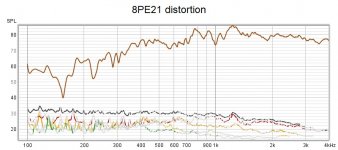
Distortion looks suspiciously low at low frequencies. This is probably not the right way of doing it. Should I drive the speaker harder and have say 90dB SPL on white noise, and the measure frequency response and distortion? I didn't graph it, but noise floor is about the same level as THD shown (but with narrow and tall spikes).
Lewinski,
With those super deep filters you can push xo lowpass higher, but matching directivities becomes more important, because of no mixing/averaging effect. But please try "normal" LR filters too, I prefer LR2 over LR4!
If dipole (or monopole as well) woofer is to be on the floor, this boundary reinforcement effect must be compensated with eq. It will "harm" the dipole pattern too, but perhaps not very much, I don't know.
Directivity measurement must be done outdoors, and groundplane for the bass frequencies. Outdoor measurement is also basis for equalization and level matching, but indoors other boundaries and room modes have their effect too, so at least level adjustment with mild Q tilt must be done. Bass room mode peak eq is a matter of taste but common practise too - Acourate can do that well I guess. But nulls will happen too...
I once had my AINOgradients in another smaller room with concrete walls, and I had to tame monopole lowest bass some 10dB! These room adjustments must be done with the speakers at normal spots, and mic at and near the listening spot, with multipoint averaged response (MMM)
With those super deep filters you can push xo lowpass higher, but matching directivities becomes more important, because of no mixing/averaging effect. But please try "normal" LR filters too, I prefer LR2 over LR4!
If dipole (or monopole as well) woofer is to be on the floor, this boundary reinforcement effect must be compensated with eq. It will "harm" the dipole pattern too, but perhaps not very much, I don't know.
Directivity measurement must be done outdoors, and groundplane for the bass frequencies. Outdoor measurement is also basis for equalization and level matching, but indoors other boundaries and room modes have their effect too, so at least level adjustment with mild Q tilt must be done. Bass room mode peak eq is a matter of taste but common practise too - Acourate can do that well I guess. But nulls will happen too...
I once had my AINOgradients in another smaller room with concrete walls, and I had to tame monopole lowest bass some 10dB! These room adjustments must be done with the speakers at normal spots, and mic at and near the listening spot, with multipoint averaged response (MMM)
Last edited:
Sorry but you don't have a clue, just assumptions based on?
An interesting way to prove something. 🙂
Music is for the ears to hear. It is a subjective feeling. My wife has much better ears than mine and music school background. Her subjective evaluation of sound is much more valuable than any measurements of instruments. Results of instruments can give an idea, what one might expect, but it is your ears that gives you the feeling.
Anyway, my "assumptions" are coming from an engineering background, for more than 4 decades. There are certain subjective feelings that no instrument can notice, for example, how my older Sony boxed speakers placed against the wall, at 90 degrees, not touching the wall, give/express sound/music coming further away from the vertical plane of the wall and more than a meter above the top of the speakers.
I had been, and still is, interested in onmi-directional sound, and had been playing with spheres, cones etc, (hard wood, soft wood, polystyrene, plastic, glass, ceramic etc). So, I have some (testing) background of sound/music matters. 🙂
I agree with much of what you are saying. But you have a strange way of addressing topics you don't understand, like why it makes sense to measure outside (the poor man's anahoic chamber). You just assume it's stupid, instead og trying to understand why.
Lewinski,
With those super deep filters you can push xo lowpass higher, but matching directivities becomes more important, because of no mixing/averaging effect. But please try "normal" LR filters too, I prefer LR2 over LR4!
If dipole (or monopole as well) woofer is to be on the floor, this boundary reinforcement effect must be compensated with eq. It will "harm" the dipole pattern too, but perhaps not very much, I don't know.
Directivity measurement must be done outdoors, and groundplane for the bass frequencies. Outdoor measurement is also basis for equalization and level matching, but indoors other boundaries and room modes have their effect too, so at least level adjustment with mild Q tilt must be done. Bass room mode peak eq is a matter of taste but common practise too - Acourate can do that well I guess. But nulls will happen too...
I once had my AINOgradients in another smaller room with concrete walls, and I had to tame monopole lowest bass some 10dB! These room adjustments must be done with the speakers at normal spots, and mic at and near the listening spot, with multipoint averaged response (MMM)
I went over the ground plane measurement approach you posted on #65. Thank you!
What do you think about measuring the (non-tilted) 18" placed on the ground with the mic on the ground? The swing makes the driver stay vertical, so if the mic were to be 1m from the driver's lower edge it would be about 23° off vertical axis. I could place the mic further away and reduce the vertical off-axis too. But from Sunday's measurements (#73) it seems 23° off axis isn't too bad.
Will do next weekend.
Thoughts on the midrange distortion graph?
Thanks for the hint on your preference for LR2 for OB! That is valuable info from an experienced OB user. I'll write it down for when the xo testing time comes.
I also use LR2. It's easy to use. Working with steep filters and/or FIR requires knowledge that I dont have. I have tried but I think it's very difficult to get right, so I stick to LR2 and soft eq
But you have a strange way of addressing topics you don't understand...
You have a nice way of trying to insult the other person. 🙂
Anyway, would you turn your OB system towards the corner of the room, at 45 degrees placed equidistant from the walls and tell us what you hear? Your subjective feeling? Maybe, ask you wife too. Thanks.
Last edited:
Thanks. I think we are done with this part
Anyway, would you turn your OB system towards the corner of the room, at 45 degrees placed equidistant from the walls and tell us what you hear? Your subjective feeling? Maybe, ask you wife too. Thanks.
There's reason behind this request. The correct subjective feeling (hearing) would help others too. Thanks!
Yes, when they are done. But please ask in my build thread or a separate thread of your own. I can then point you to my old design that might interest you
I also use LR2. It's easy to use. Working with steep filters and/or FIR requires knowledge that I dont have. I have tried but I think it's very difficult to get right, so I stick to LR2 and soft eq
Thanks for the input!
Is your system active/passive? digitally active?
FWIW, I have been using Acourate for a long time and while the learning curve is significant, I have been very pleased with the results. It makes it easier to implement very sophisticated stuff, but not simplistic so you still have a lot of control.
Mid distortion measurement has too low signal spl. Try 95 dB at 1m next, and with dipole eq. You can do this indoors, just check there isnt anything resonating in the room.
Thanks for the input!
Is your system active/passive? digitally active?
FWIW, I have been using Acourate for a long time and while the learning curve is significant, I have been very pleased with the results. It makes it easier to implement very sophisticated stuff, but not simplistic so you still have a lot of control.
I use cheap digital xover from Thomann. So digital active system
Midrange measurements outside
I was able to run outside measurements of the B&C 8PE21 on a swing, 0 to 180°. Driver and mic were about 2.2m above ground (this time concrete). It was windy again, in fact quite windy. The driver balance with about 2cm amplitude (1cm each way), and the mic moved too.
Simulation on The Edge:
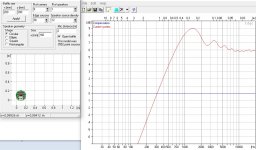
Front measurements 0 to 90° at 15° increments, with 1/12 smoothing applied:
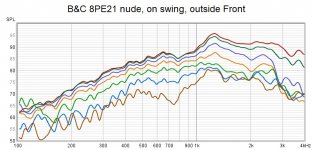
Seems well behaved. At 300Hz it's exactly 6dB down vs 600Hz. I was hoping to be able to xo at 2kHz, but it might be too high, looking at the drop at 2kHz and 45°. Right now I'm crossing at 1.5kHz.
Back, 105 to 180°:
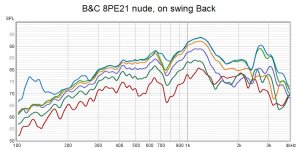
Kind of as expected for a driver with such a large diameter motor, not as clean as the front. I guess the dip around 800Hz is somehow related to that. And drops fast after 1.5kHz.
Front vs back:
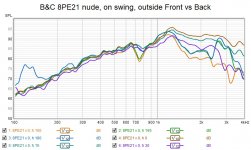
The higher response at the 180° measurement at low frequencies must be wind, which was picking up towards the end. In fact I decided not to measure the tweeter because of the wind.
This time measurements were done at 90dB (vs 75dB last weekend for the 18"). Here's the distortion plot of the on-axis measurement:
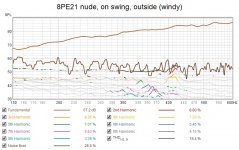
I think the noise floor (wind) was just too high to arrive at any conclusions. According to the graph, at 300Hz THD is about 30dB below signal, but don't know if this measurement is to be relied upon.
Thoughts?
I was able to run outside measurements of the B&C 8PE21 on a swing, 0 to 180°. Driver and mic were about 2.2m above ground (this time concrete). It was windy again, in fact quite windy. The driver balance with about 2cm amplitude (1cm each way), and the mic moved too.
Simulation on The Edge:

Front measurements 0 to 90° at 15° increments, with 1/12 smoothing applied:

Seems well behaved. At 300Hz it's exactly 6dB down vs 600Hz. I was hoping to be able to xo at 2kHz, but it might be too high, looking at the drop at 2kHz and 45°. Right now I'm crossing at 1.5kHz.
Back, 105 to 180°:

Kind of as expected for a driver with such a large diameter motor, not as clean as the front. I guess the dip around 800Hz is somehow related to that. And drops fast after 1.5kHz.
Front vs back:

The higher response at the 180° measurement at low frequencies must be wind, which was picking up towards the end. In fact I decided not to measure the tweeter because of the wind.
This time measurements were done at 90dB (vs 75dB last weekend for the 18"). Here's the distortion plot of the on-axis measurement:

I think the noise floor (wind) was just too high to arrive at any conclusions. According to the graph, at 300Hz THD is about 30dB below signal, but don't know if this measurement is to be relied upon.
Thoughts?
If I were in your position, I would start with 180 degree polars, probably just horizontal to begin with to see if it can be done. Both tweeter and mid. In room is ok if you can get clean down into the mid hundreds or so.
I'd be looking to see where and how the B&C struggles with the highs from the back. Whether it would be possible to use this, and to blend somehow to meet the tweeter.
Finally I guess, if there is a remaining imbalance, you could tweak by using an absorber on the wall behind the speaker which is thin enough only to catch some of the upper midrange.
Hey Allen!
Please not the post above with 190 degree polars for the B&C. What do you think?
Today I measured the TPL outside. It was 2.2m above a hard floor, with no other nearby surfaces. It was windy again, but at least the TPL is not on a swing.
Front measurements 0 to 90°, every 15°, with a protection cap at 1.1kHz approx:
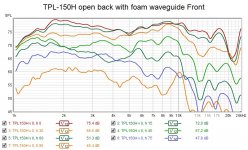
I assembled a simplified foam wave on the back, with similar depth to the Beyma waveguide:
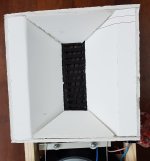
These are the back measurements, 105 to 180°, every 15°:
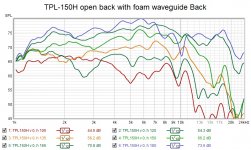
Seems response is fine above 7kHz, which was mentioned before as a threshold for meaningfulness for the back wave.
Would you agree 1.5 to 1.6kHz should be ok for xo, and dipole behavior seems acceptable?
Front measurements 0 to 90°, every 15°, with a protection cap at 1.1kHz approx:

I assembled a simplified foam wave on the back, with similar depth to the Beyma waveguide:

These are the back measurements, 105 to 180°, every 15°:

Seems response is fine above 7kHz, which was mentioned before as a threshold for meaningfulness for the back wave.
Would you agree 1.5 to 1.6kHz should be ok for xo, and dipole behavior seems acceptable?
- Home
- Loudspeakers
- Multi-Way
- 3-way open baffle plus subs